Right now in Punta Gorda town - Organizers of the 2011 Cacao Festival are hosting the Wine and Chocolate Festival - an evening full of decadent chocolate creations from Belize's foremost chocolate makers. Our team of Monica Bodden and Victor Noble are in the middle of it - and the best that we can do down here is imagine all that chocolate goodness they are getting into.
We'll see their story next week - but tonight we'll look back into our archives to July of 2009 when we visited one of those chocolate makers called Cotton Tree right in Punta Gorda Town. The showed us how they make dark, lustrous chocolate from Cacao grown right in the Toledo district:…
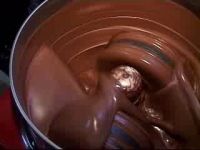
In May we took you on the cacao trail to see what Toledo's farmers
go through to produce one of Belize most prized exports, cacao beans.
Farmed organically by Mayans in the Toledo District, these beans are among the best
in the world. Well tonight, we´ll take on that other step in the life
of a cacao bean - into the process where those same beans are used locally to
produce a chocolate product that is 100% Belizean. The product is called Cotton
Tree Chocolates, but the first thing you have to know is that they have nothing
to do with that village at mile 43 on the Western Highway. These chocolates
are named off the towering and imperious tree that straddles the jungles
of Toledo. And while the chocolate producers have similar ambitions for their
chocolate venture, they plan to progress by humble means. We visited the factory
and its three workers.
Jules Vasquez Reporting,
The process begins with these, cacao beans grown by farmers in the Toledo District.
These ones come from Eladio Pop's farm. You may remember him, he is the
cacao grower who is loco for his cacao puffs. Well some of his cacao nuts end
up here, at Wilma Wonka's Chocolate Center in downtown Punta Gorda. They
are the producers of Cotton Tree Chocolates, self-titled as a chocolate center
of the universe.
Julie Puryear,
"We make chocolate from cacao beans that grown right here in southern
Belize and we go all the way through many processes which you will see to make
it into chocolate bars."
It starts here with the dried fermented cacao nuts which are roasted right
here in this small oven for thirty minutes. Anika Harry is one of three employees
here at Cotton Tree Chocolate Factory.
Anika Henry, Employee
"After the roasting stopped for thirty minutes, we bring it and we 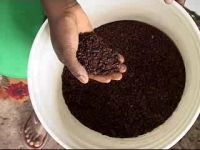 put it in this grinding machine and we grind it like this."
put it in this grinding machine and we grind it like this."
It is a rudimentary grinder with a battery operated power drill, a pot to gather
the nuts. The drill grinds them up and this is what you get – a bucket
full of ground beans called nibs. They get the special treatment from a blow
dryer.
Anika Henry,
"You can see the shells blowing."
And when that's done they are cleaned and have a lovely lustrous earthy
colour and not only does it look good, it is good enough to eat but it doesn't
taste anything like chocolate. And while I would happily eat them out, these
nibs have work to do.
Anika Henry,
"We take the nibs and we put it into this mixing machine and we press
it like this."
This machine separates the starch which is useless from what's called 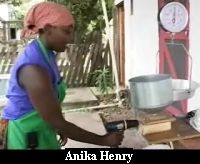 the cacao liquor which is what it's all about. It is hard for the uninitiated
to tell them apart but the shiny liquor is the one the chocolate will be made
of eventually. It is a manual process, one many in this production chain, but
it is a key one because it transforms the roasted ground beans into a liquid
and it provides the key ingredient, one of five that will be combined to make
a chocolate. Those five are sugar, powdered milk, vanilla beans, and coco butter
in a hardened form which is also made right here at the factory, the product
of another time consuming and difficult manual process,
the cacao liquor which is what it's all about. It is hard for the uninitiated
to tell them apart but the shiny liquor is the one the chocolate will be made
of eventually. It is a manual process, one many in this production chain, but
it is a key one because it transforms the roasted ground beans into a liquid
and it provides the key ingredient, one of five that will be combined to make
a chocolate. Those five are sugar, powdered milk, vanilla beans, and coco butter
in a hardened form which is also made right here at the factory, the product
of another time consuming and difficult manual process,
Anika Henry,
"We add the ingredients here in this machine, the sugar, the cocoa
butter, the liquor, the milk, and the vanilla beans. So this machine spins twenty
four hours a day for three days."
This machine oddly is called a conch, just like the conch in the sea but it
has nothing to do with that. Instead it is a fast humming beauty. Imported from
India it has granite stone grinding wheels which steadily stirs the chocolate
mix, slowly refining it until it has no grit. This is the heart of the operation,
the strange and oddly sensual alchemy of chocolate making where the mix becomes
a lustrous deep mahogany texture. And while I found it almost hypnotic, the
process is central, it's functional because it cuts the sharp taste of
the cacao and produces the delicious chocolate flavour we all know so well.
I was allowed to dip straight from this fountain of flavour.
But before I ate them out, they quickly poured out the glistening caramel coloured
conch mix. It goes here to this device known as a tempering machine. It is an
electronic mixing and heating appliance that makes sure the chocolate you get
doesn't look like this. It does that through a precise computer controlled
process of heating and cooling. From the tempering machine it goes into the
mould which is the beginning of the chocolate.
Vilma Velez, Employee
"You take the chocolate and make it to vibrate."
And while not computer controlled, this isn't easy. I tried and it was
an unmitigated disaster. Fortunately my mould was thrown away, had to be thrown 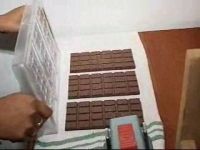 away, and the proper moulds were put together. Once the mould is full.
away, and the proper moulds were put together. Once the mould is full.
Vilma Velez,
"You set it on the shelf to get dry."
And from there it is almost done, leaving us with this: shiny crisp looking
chocolate bars. After that it is packaged which is another level of precision
which I hadn't even attempt. And after its foil wrapped, its time for
the brand name to be applied.
Julie Puryear,
"This is our packaging; it depends on which type of chocolates that
we are making. This one is with milk. If it is light milk we use the light milk 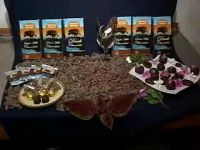 packaging because we have three kinds. This is how we package them. We use the
glue gun."
packaging because we have three kinds. This is how we package them. We use the
glue gun."
And there it is, the finished product made in Belize from beginning to end,
all with the love and tenderness of hand preparation. The milk chocolate we
saw prepared is only one of a host of products made by Cotton Tree Chocolate.
There are the standard 45, 55 and 70% chocolate mixes and all kinds of artisan
chocolates, the ones with the beans on top are stuffed with Mayan coffee and
each product is made painstakingly by hand including these dried stripes of
mangoes coated in chocolate and this new experimental products, One Barrel Chocolates.
Julie Puryear,
"They are fun to eat and they are fun to look at and we think it is
a great product because it is a combination of two great Belizean things; chocolate
and one barrel rum."
All of them taste great but maybe not to you. Dark organic chocolate is an
acquired taste. This isn't a Snickers bar.
Julie Puryear,
"Well they are less sweet than what people are accustomed to. We have
one bar is 40% light chocolate which people would be more familiar with. It
is sweeter and creamy. Our dark chocolate is 70% chocolate so it is not quite
as sweet and it is just an acquired taste."
The Cacao festival continues tomorrow with the Taste of Toledo which includes a chocolate Center at the same Chocolate Factory you just saw and many other attractions….
Events continue right up until Sunday - so it isn't too late to head out there.
You can find the full schedule at 7newsbelize.com
http://www.toledochocolate.com/



